How Microsoft Fabric Supports Collaboration in Data Teams
Microsoft Fabric transforms how you collaborate within your data team. It provides a unified platform that simplifies workflows and connects everyone, from data engineers to business analysts. With its integrated tools and real-time data sharing, you can focus on solving problems instead of managing disconnected systems. By bridging the gap between technical and non-technical users, Microsoft Fabric ensures everyone contributes effectively. Studies even show a 25% boost in productivity for data engineers, saving organizations millions. Mastering Microsoft Fabric means unlocking seamless teamwork and driving better decisions for your business.
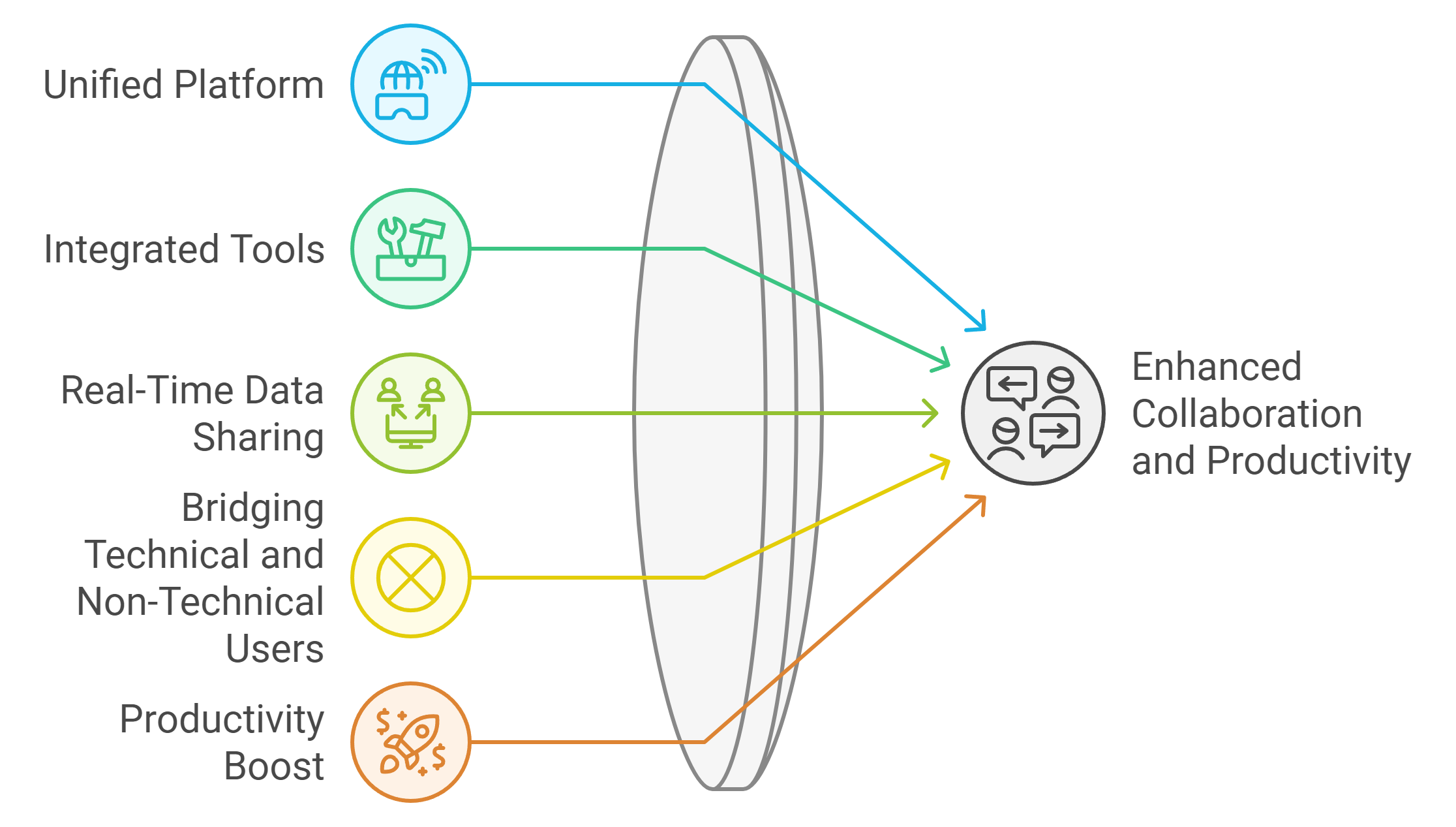
Key Takeaways
Microsoft Fabric unifies data tools, enhancing collaboration among data engineers, analysts, and business leaders, leading to a more efficient workflow.
Real-time data sharing ensures that all team members work with the most current information, reducing errors and improving decision-making.
AI-powered features in Microsoft Fabric provide instant insights and predictive analytics, empowering teams to make informed decisions quickly.
Centralized workspaces eliminate silos, allowing for seamless collaboration and transparency across diverse roles within data teams.
Automating repetitive tasks with Microsoft Fabric saves time and reduces human error, enabling teams to focus on strategic initiatives.
Organizations using Microsoft Fabric report significant productivity boosts, with studies showing a 25% increase in data engineering efficiency.
By fostering a culture of collaboration, Microsoft Fabric helps align business and data strategies, driving better outcomes and competitive advantage.
Understanding Microsoft Fabric and Its Role in Collaboration
What Is Microsoft Fabric?
Microsoft Fabric is a cloud-based platform designed to simplify how you manage and analyze data. It combines tools like Azure Data Factory, Azure Synapse Analytics, and Power BI into one unified system. This integration eliminates the need for juggling multiple platforms, making your workflows more efficient. By offering a secure Software-as-a-Service (SaaS) environment, it ensures your data remains protected while being accessible to your team.
The platform also supports open data formats, such as Delta Parquet, which enhances compatibility and reduces vendor lock-in. Whether you're a data engineer, analyst, or business leader, Microsoft Fabric provides a consistent experience that helps you focus on insights rather than technical hurdles. Its end-to-end capabilities empower you to integrate, analyze, and leverage data for actionable results.
Why Collaboration Matters in Data Teams
Collaboration is the backbone of successful data projects. When your team works together effectively, you achieve faster results and more accurate insights. Data teams often consist of diverse roles, from engineers to analysts, each bringing unique expertise. Without proper collaboration, these roles can become siloed, leading to miscommunication and inefficiencies.

Microsoft Fabric addresses this challenge by fostering a collaborative environment. It allows you to share SQL queries, semantic models, and dashboards across your team. This ensures everyone works with consistent data, reducing errors and improving decision-making. By breaking down barriers between technical and non-technical users, it creates a shared understanding that drives unified goals.
How Microsoft Fabric Facilitates Teamwork
Microsoft Fabric takes teamwork to the next level by providing tools and features that enhance collaboration. Shared workspaces allow multiple users to contribute to projects simultaneously. You can securely share data, reports, and dashboards with role-based access, ensuring the right people have the right information.
The platform's integration with familiar tools like Power BI makes it easier for your team to communicate and align on objectives. A consistent user interface across all tools ensures a seamless experience, reducing the learning curve for new users. Additionally, its AI-powered features enable real-time data analysis, helping your team make informed decisions together.

By streamlining workflows and promoting transparency, Microsoft Fabric transforms how your team collaborates. It bridges gaps between roles, simplifies complex processes, and ensures everyone stays on the same page.
Unified Analytics Platform for Data Teams
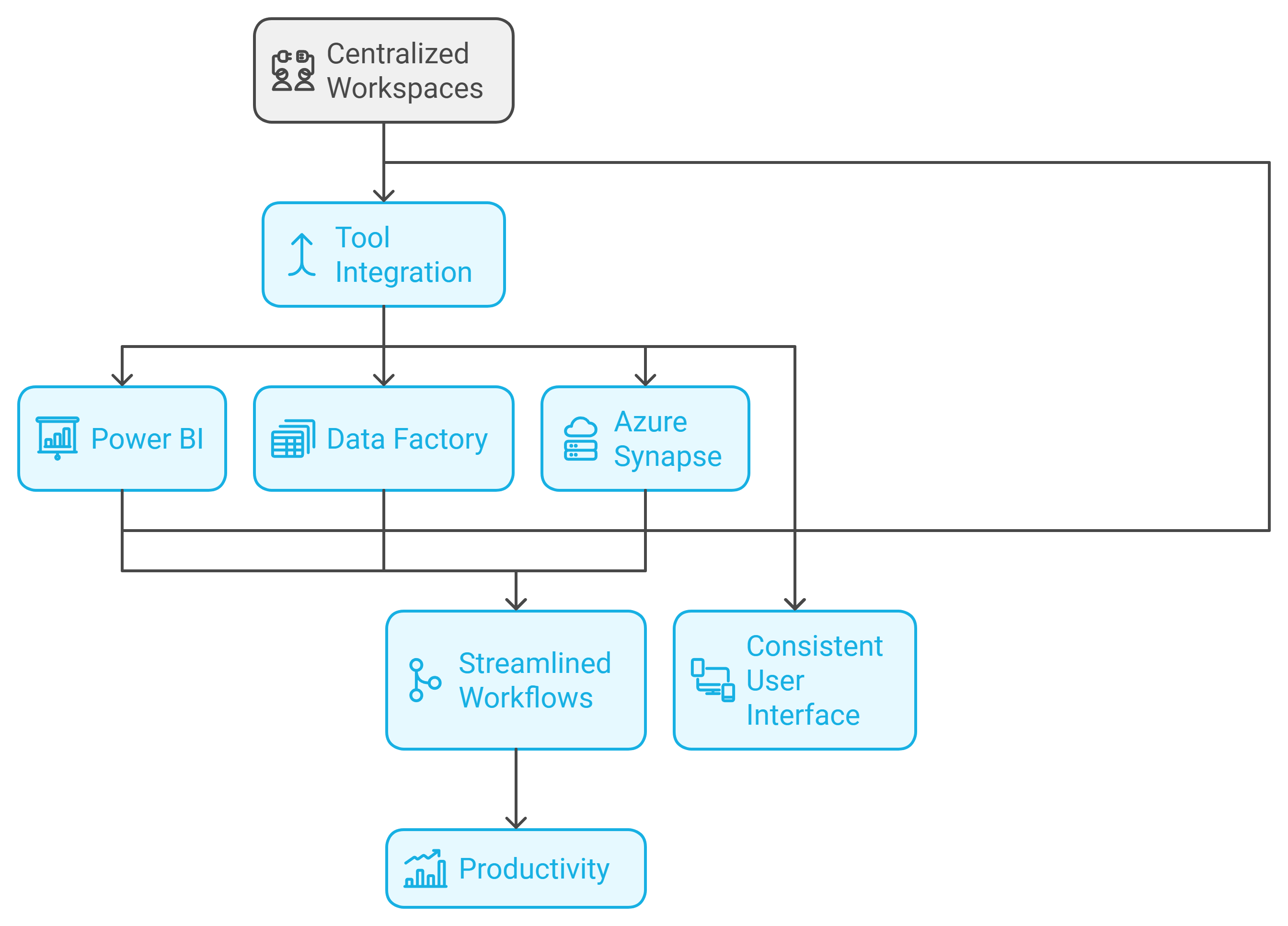
Centralized Workspaces for Seamless Collaboration
Imagine having all your data projects in one place. Microsoft Fabric offers centralized workspaces where your entire team can collaborate without jumping between platforms. These shared spaces let you organize datasets, reports, and analytics tools in a single environment. Everyone on your team, from data engineers to business analysts, can access the same resources, ensuring consistency and reducing confusion.
With centralized workspaces, you can assign roles and permissions to team members. This ensures that sensitive data stays secure while still being accessible to those who need it. You no longer have to worry about version control issues or miscommunication. Instead, your team can focus on delivering insights and driving results.
Integration of Tools Like Power BI, Data Factory, and Azure Synapse
Microsoft Fabric brings together powerful tools like Power BI, Data Factory, and Azure Synapse into one unified platform. This integration eliminates the hassle of switching between different applications. For example, you can use Data Factory to prepare your data, Azure Synapse to analyze it, and Power BI to visualize the results—all without leaving the platform.
This seamless integration streamlines your workflows. You can move from data ingestion to analysis to reporting in a fraction of the time it would take using separate tools. The platform also supports open data formats like Delta Parquet, which enhances compatibility and ensures your data remains accessible across different systems. By combining these tools, Microsoft Fabric simplifies complex processes and boosts your team's productivity.
Consistent User Interface for Cohesive Teamwork
A consistent user interface makes a world of difference when working as a team. Microsoft Fabric provides a uniform design across all its integrated tools. Whether you're creating a dashboard in Power BI or running queries in Azure Synapse, the interface feels familiar and intuitive.
This consistency reduces the learning curve for new users and helps your team work more efficiently. You won't waste time figuring out how to navigate different tools. Instead, you can focus on collaborating and achieving your goals. A cohesive interface also fosters better communication among team members, as everyone speaks the same "language" when using the platform.
By offering centralized workspaces, integrating essential tools, and maintaining a consistent user interface, Microsoft Fabric transforms how your data team collaborates. It creates an environment where teamwork thrives, enabling you to deliver faster, more accurate insights.
Real-Time Data Sharing and Communication
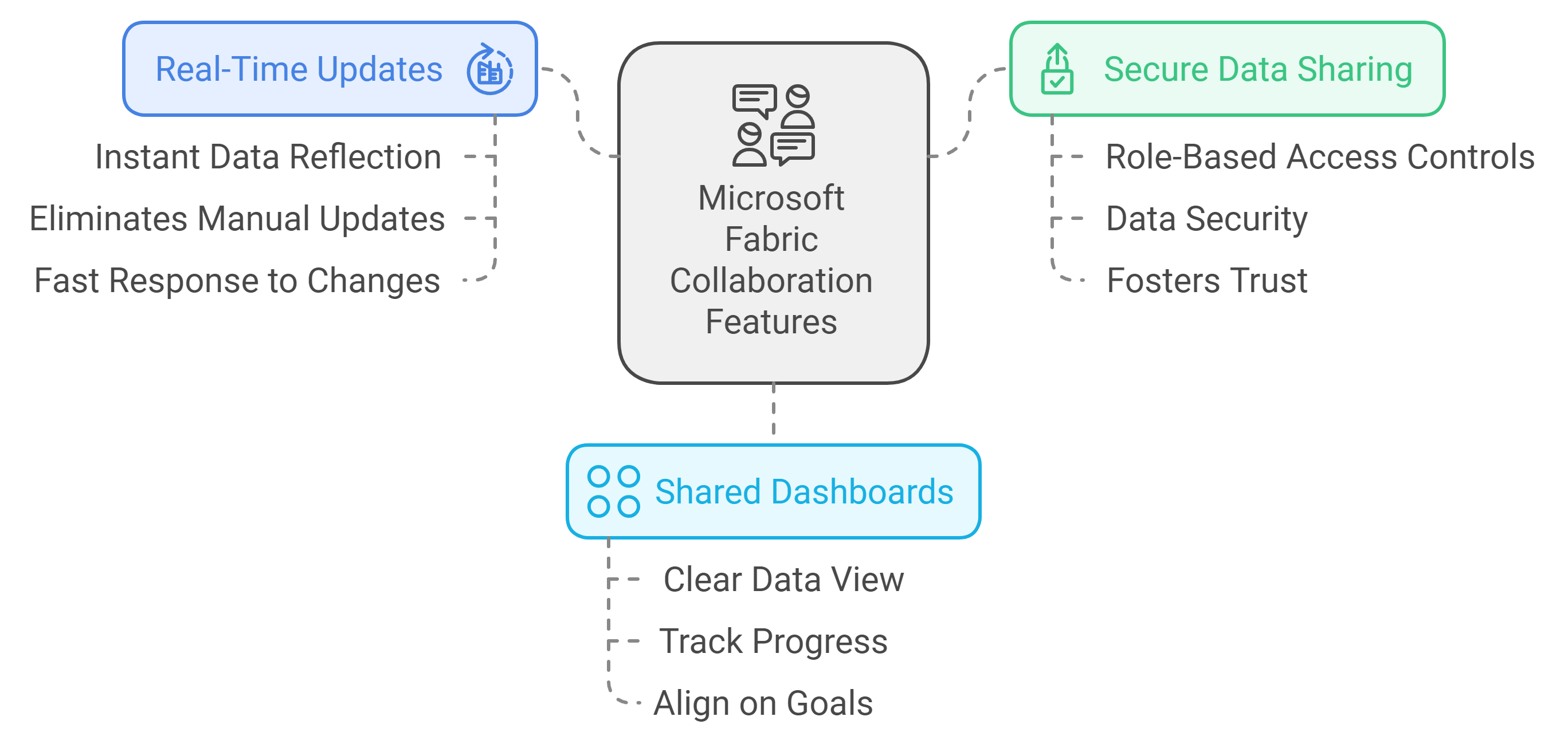
Instant Updates Across Teams
Keeping everyone on the same page is crucial for effective teamwork. With Microsoft Fabric, your team gains access to real-time updates, ensuring no one works with outdated information. As soon as changes occur in your data, they reflect instantly across the platform. This eliminates delays caused by manual updates or version mismatches.
For example, when a data engineer modifies a dataset, analysts and business users see the changes immediately. This seamless synchronization allows your team to respond faster to evolving business needs. Whether you're analyzing trends or preparing reports, you can trust that the data you're using is always up-to-date.
Secure and Role-Based Data Sharing
Data security is non-negotiable, especially when multiple team members access sensitive information. Microsoft Fabric addresses this by offering robust role-based access controls. You decide who can view, edit, or share specific datasets, ensuring that only authorized users handle critical information.
This feature not only protects your data but also fosters trust within your team. Everyone knows their access aligns with their responsibilities, reducing the risk of errors or breaches. By combining security with flexibility, Microsoft Fabric empowers your team to collaborate confidently without compromising data integrity.
Shared Dashboards and Reports for Transparency
Transparency drives better decision-making. With Microsoft Fabric, you can create shared dashboards and reports that provide a clear view of your data. These tools allow your team to track progress, identify trends, and align on goals effortlessly.
Shared dashboards ensure everyone works with the same insights, eliminating confusion caused by fragmented data sources. For instance, business leaders can monitor key performance indicators (KPIs) while analysts dive deeper into the details—all within the same platform. This unified approach promotes accountability and keeps your team focused on achieving results.
By enabling instant updates, secure sharing, and transparent reporting, Microsoft Fabric transforms how your team communicates and collaborates. It ensures everyone stays informed, aligned, and empowered to make data-driven decisions.
Streamlined Workflows with Microsoft Fabric

Automation of Repetitive Tasks
Repetitive tasks can drain your time and energy. Microsoft Fabric helps you reclaim that time by automating these processes. Instead of manually cleaning datasets or running the same queries repeatedly, you can set up automated workflows. These workflows handle routine tasks like data ingestion, transformation, and validation without requiring constant oversight.
For example, if you frequently update sales reports, Microsoft Fabric can automate the entire process. It pulls the latest data, applies necessary transformations, and updates dashboards in real time. This automation not only saves hours of manual effort but also reduces the risk of human error. You can focus on more strategic tasks while the platform takes care of the repetitive ones.
Workflow Templates for Common Data Processes
Starting from scratch every time you work on a data project can be frustrating. Microsoft Fabric offers pre-built workflow templates to simplify common data processes. These templates cover tasks like data integration, ETL (Extract, Transform, Load) pipelines, and report generation. You can customize them to fit your specific needs, saving time and ensuring consistency.
Imagine you're setting up a pipeline to analyze customer feedback. Instead of building it step by step, you can use a template designed for text analysis. The template provides a ready-made structure, so you only need to tweak it for your data. This approach accelerates your projects and ensures best practices are followed. With these templates, you can hit the ground running and deliver results faster.
Integration with Existing Systems for Efficiency
Switching between multiple platforms can disrupt your workflow. Microsoft Fabric eliminates this issue by integrating seamlessly with your existing systems. Whether you're using CRM tools, ERP software, or cloud storage solutions, the platform connects everything in one place. This integration streamlines your operations and ensures data flows smoothly across systems.
For instance, you can link your customer database to Microsoft Fabric and automatically sync updates. When new customer data is added, it becomes instantly available for analysis and reporting. This connectivity reduces manual data transfers and keeps your team aligned. By integrating with your current tools, Microsoft Fabric enhances efficiency and minimizes disruptions.
"Microsoft Fabric has been instrumental in helping businesses transform their data into actionable insights." This transformation becomes even more impactful when workflows are streamlined, enabling teams to focus on innovation rather than mundane tasks.
By automating repetitive tasks, offering workflow templates, and integrating with existing systems, Microsoft Fabric revolutionizes how you manage your data processes. It empowers you to work smarter, not harder, and ensures your team operates at peak efficiency.
AI-Powered Features for Enhanced Collaboration

Real-Time Data Analysis with AI
AI transforms how you analyze data by delivering insights instantly. With Microsoft Fabric, you can harness AI to process massive datasets in real time. This means you no longer have to wait hours—or even days—for results. Instead, you can make decisions based on the most current information available.
AI tools within the platform identify patterns and anomalies faster than any human could. For example, if your sales data shows an unexpected dip, AI flags it immediately. This allows your team to investigate and respond without delay. By integrating AI into your workflows, you ensure your team stays ahead of challenges and opportunities.
"Artificial collaborators can process and analyze large data sets faster and with more precision than humans." This capability empowers your team to focus on strategy while AI handles the heavy lifting.
Predictive Insights for Collaborative Decision-Making
Making decisions becomes easier when you can see what’s coming. Microsoft Fabric uses AI to provide predictive insights, helping your team anticipate trends and outcomes. These forecasts allow you to plan proactively rather than reactively.
For instance, AI might analyze customer behavior and predict which products will perform well next quarter. Your team can then align their efforts to maximize those opportunities. Predictive insights also enhance collaboration by giving everyone a shared understanding of future possibilities. When your team works from the same playbook, decision-making becomes faster and more effective.
AI doesn’t just crunch numbers—it augments your team’s ability to think ahead. By combining human intuition with machine precision, you unlock a new level of collaborative intelligence.
Bridging Technical and Non-Technical Users
AI acts as a bridge between technical and non-technical team members. Microsoft Fabric’s AI-powered features simplify complex data processes, making them accessible to everyone. You don’t need to be a data scientist to understand the insights AI provides.
For example, AI can generate visualizations that explain trends in plain language. A business analyst can interpret these visuals just as easily as a data engineer. This shared understanding fosters better communication and teamwork across roles.
By breaking down technical barriers, AI ensures every team member contributes meaningfully. Whether you’re building models or presenting findings, AI helps you collaborate without confusion or misalignment.
"Collaborative intelligence applies AI solutions to augment human productivity, helping teams and businesses realize their full potential." With Microsoft Fabric, this potential becomes a reality for your team.
Practical Use Cases of Microsoft Fabric in Data Teams
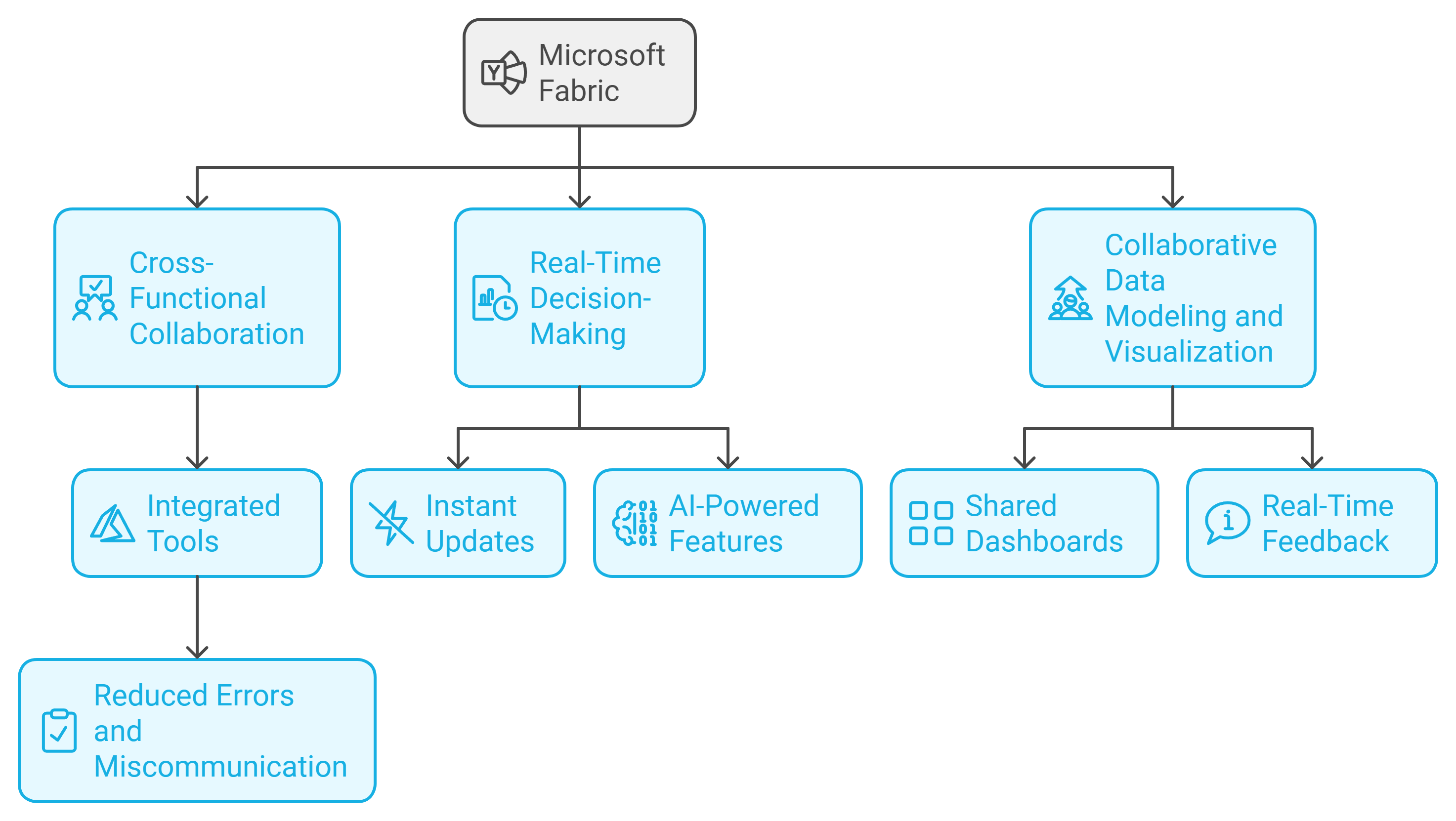
Cross-Functional Collaboration Between Analysts and Engineers
Microsoft Fabric creates a unified environment where analysts and engineers can work together seamlessly. Traditionally, these roles often face challenges due to differing tools, workflows, or even communication gaps. With Microsoft Fabric, you get a single platform that integrates tools like Power BI, Azure Synapse Analytics, and Data Factory. This integration eliminates the need to switch between systems, allowing both analysts and engineers to focus on their expertise while staying aligned.
For example, an engineer can prepare and transform raw data using Azure Synapse, while an analyst simultaneously builds visualizations in Power BI. Shared workspaces ensure everyone accesses the same datasets and insights, reducing errors and miscommunication. By breaking down silos, Microsoft Fabric fosters collaboration that drives faster and more accurate results.
"Microsoft Fabric facilitates collaboration between different roles in a single, integrated Software-as-a-Service (SaaS) environment." This means your team can focus on solving problems instead of navigating disconnected systems.
Real-Time Decision-Making in Business Operations
In today’s fast-paced world, making decisions quickly can give your business a competitive edge. Microsoft Fabric empowers your team to make real-time decisions by providing instant updates across the platform. When data changes, everyone sees the updates immediately, ensuring no one works with outdated information.
Imagine monitoring sales performance during a product launch. As new data flows in, your team can analyze trends, identify issues, and adjust strategies on the fly. The platform’s AI-powered features also enhance this process by identifying patterns and providing predictive insights. This allows your team to act proactively rather than reactively, keeping your operations agile and effective.
Real-time decision-making becomes a reality when your entire team works with synchronized data and tools. Microsoft Fabric ensures you stay ahead of challenges and seize opportunities as they arise.
Collaborative Data Modeling and Visualization
Data modeling and visualization often require input from multiple team members. Microsoft Fabric simplifies this process by offering tools that support collaborative workflows. Whether you’re building a semantic model or designing a dashboard, the platform ensures everyone contributes effectively.
For instance, a data engineer can create a robust data model in Azure Synapse, while a business analyst uses Power BI to craft interactive dashboards. Shared dashboards provide transparency, allowing stakeholders to review and provide feedback in real time. This collaborative approach ensures your visualizations align with business goals and deliver actionable insights.
By integrating data modeling and visualization into a single platform, Microsoft Fabric streamlines the entire process. Your team can focus on creating impactful insights without worrying about compatibility or version control issues.
Benefits of Collaboration with Microsoft Fabric

Faster Insights Through Teamwork
When your team collaborates effectively, you uncover insights faster. Microsoft Fabric creates an environment where everyone works together seamlessly. Shared workspaces and real-time updates ensure that all team members access the same data and tools. This eliminates delays caused by miscommunication or outdated information.
For example, a data engineer can prepare datasets while an analyst simultaneously builds visualizations. This parallel workflow speeds up the entire process. A recent survey revealed that companies using Microsoft Fabric experienced a 25% boost in data engineering productivity. This increase translates to faster project completion and quicker decision-making.
By fostering teamwork, Microsoft Fabric helps you deliver insights at a pace that keeps your business ahead of the competition.
Improved Accuracy and Consistency in Data Analysis
Collaboration reduces errors and ensures consistent results. Microsoft Fabric provides a unified platform where your team works with a single source of truth. Everyone uses the same datasets, models, and dashboards, minimizing discrepancies.
Role-based access controls further enhance accuracy. Team members only access the data they need, reducing the risk of accidental changes. Shared dashboards also allow stakeholders to review and validate findings, ensuring alignment across the board.
This consistency leads to better outcomes. Companies leveraging Microsoft Fabric report significant savings—up to $1.8 million annually. These savings come from fewer errors, streamlined workflows, and improved data reliability. When your team collaborates effectively, you achieve results you can trust.
Enhanced Innovation Through Shared Knowledge
Innovation thrives when people share ideas. Microsoft Fabric breaks down silos, enabling your team to collaborate across roles and departments. Data engineers, analysts, and business leaders contribute their unique perspectives, leading to creative solutions.
Shared workspaces and AI-powered tools make it easy to exchange knowledge. For instance, an engineer might identify a pattern in the data, while an analyst suggests how to visualize it for stakeholders. This cross-functional collaboration sparks innovation that drives your business forward.
The return on investment speaks volumes. Organizations using Microsoft Fabric report a 379% ROI, highlighting the value of collaborative innovation. By working together, your team unlocks new opportunities and achieves breakthroughs that set your business apart.
Impact of Microsoft Fabric on Business Outcomes
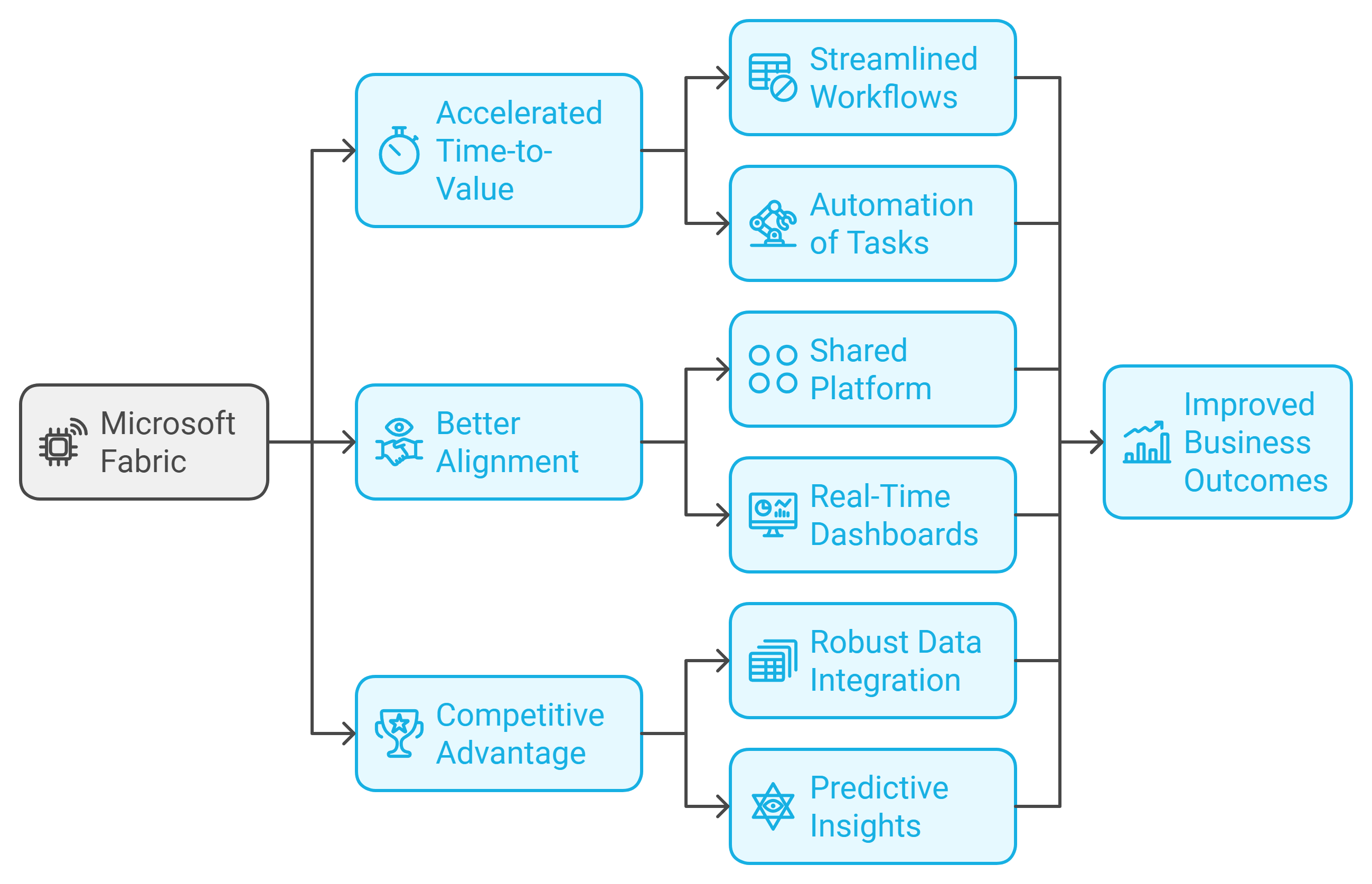
Accelerated Time-to-Value for Data Projects
Time is money, especially in data-driven projects. Microsoft Fabric helps you achieve faster results by streamlining workflows and automating repetitive tasks. With its unified platform, your team can move from data ingestion to actionable insights in record time. Studies show that organizations using Microsoft Fabric experience a 90% reduction in time spent on data tasks. This means you can deliver insights faster, meet tight deadlines, and respond quickly to business needs.
For example, instead of spending hours manually preparing datasets, you can use pre-built workflow templates to automate the process. This efficiency not only saves time but also ensures accuracy. By accelerating time-to-value, Microsoft Fabric empowers your team to focus on strategic initiatives rather than getting bogged down by operational delays.
"Companies using Microsoft Fabric report a 25% boost in data engineering productivity, translating to an estimated $1.8 million in savings." Faster project completion directly impacts your bottom line, making every second count.
Better Alignment Between Business and Data Teams
Misalignment between business goals and data strategies often leads to wasted resources and missed opportunities. Microsoft Fabric bridges this gap by creating a shared platform where business leaders and data teams collaborate seamlessly. Everyone works with the same data, tools, and insights, ensuring alignment across the board.
For instance, business leaders can access real-time dashboards to monitor KPIs, while data teams focus on refining models and analyses. This shared understanding fosters better communication and ensures that data-driven decisions align with organizational objectives. By integrating advanced analytics and role-based access, Microsoft Fabric eliminates silos and promotes a culture of collaboration.
When your business and data teams work in harmony, you achieve more consistent results. This alignment not only improves decision-making but also enhances overall productivity, driving your organization toward its goals.
Competitive Advantage Through Collaborative Data Strategies
In today’s fast-paced market, staying ahead requires more than just good data—it demands collaboration. Microsoft Fabric gives you a competitive edge by enabling your team to work together efficiently. Its robust data integration capabilities allow you to manage vast amounts of data from multiple sources, providing a comprehensive view of your business.
With predictive insights powered by AI, your team can anticipate trends and make proactive decisions. For example, identifying customer behavior patterns early can help you tailor marketing strategies or optimize product offerings. This ability to act quickly and strategically sets you apart from competitors.
"Organizations leveraging Microsoft Fabric report a 379% ROI, highlighting its transformative impact on business outcomes." By fostering collaboration and innovation, Microsoft Fabric positions your business as a leader in the data-driven economy.
When you combine faster project timelines, better team alignment, and a collaborative approach, the result is a significant competitive advantage. Microsoft Fabric doesn’t just help you keep up—it helps you lead.
Microsoft Fabric transforms how your data team collaborates. It provides a unified platform that simplifies workflows and connects everyone, from engineers to analysts. Real-time data sharing ensures your team always works with the latest information, while AI-powered tools enhance decision-making. By streamlining processes and fostering teamwork, Microsoft Fabric boosts productivity and drives impactful business outcomes. Organizations using this platform unlock greater success in their data-driven initiatives, achieving faster insights and stronger alignment across teams. With Microsoft Fabric, you can turn collaboration into a competitive advantage.
See Also
Effective Collaboration in Data Science Using Microsoft Fabric
The Impact of Microsoft Fabric on Data Management
Boosting Business Intelligence with Microsoft Fabric Solutions
Three Ways Microsoft Fabric Revolutionizes Data Science
Seamlessly Integrating Microsoft Fabric into Your Data System
